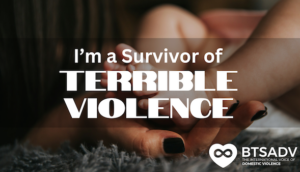Types of Domestic Violence
Domestic violence is a term used for abusive behaviors used by an individual to gain power and control over another person within an intimate relationship. Acts of domestic violence can range from a single, isolated episode to multiple acts spanning over a long time period. Please keep in mind, isolated incidents may still have a lasting impact on both the victim and the abuser. The spectrum of domestic violence behaviors impact all demographics regardless of socioeconomic status, race, age, gender, religion or culture. These actions include:
- Physical violence – using a physical force to hurt or physically control
- Sexual violence – forcing or attempting to force a partner to participate in a sexual event when the partner does not or cannot consent
- Psychological aggression – verbal and non-verbal communication with the intent to impact the partner mentally or emotionally to exert control
- Stalking – repeated, unwanted attention and contact by a partner which causes fear or concern for safety of either the victim or someone close to the victim.
Risk Factors of Domestic Violence
There is generally no definitive reason why an abuser feels the need to exert control over their victim. This makes it difficult to predict. There are often common factors to look for, including but not limited to:
- Low self-esteem
- Inferiority complex
- Jealousy
- Anger management issues
- Belief in having the right to control their partner
- Personality or psychological disorder
- Learned behavior– repeating a family pattern of abuse
- Alcohol and drugs– which lower impulse control
Childhood abuse is commonly associated with individuals resorting to domestic violence as in adulthood. When violence is a learned or normalized behavior it can be difficult to break the pattern taught in childhood. The abuser may think their reactions are reasonable, because it is what was modeled to him or her. Likewise, the abuser may be resorting to violent reactions because healthy reactions were never taught to them in formative years. Similarly, females who were exposed to domestic violence as children are more likely to be abused by their adult partners. They may also think they ‘deserved’ the reaction, or ‘started the fight’ because it’s how their family behaved.
Males who believe females shouldn’t be equally respected are more likely to abuse females into adulthood. Whilst females are more commonly the victims of these acts of violence, females can also become the abusers. Male victims are even less likely to come forward than female victims, so it’s challenging to collect accurate statistics on cases of male victims.
Same-sex partner abuse is also common with approximately 35% of heterosexual females, 40% of lesbians and 60% of bisexual women experiencing domestic violence. There are generally more cases of domestic violence among males living with male partners than males living with female partners. Transgender individuals are at significantly higher risk of domestic violence and are approximately two times more likely to be victimized.
Perhaps the most critical statistic of all: a person who has committed domestic violence in the past will often repeat his or her patterns of control and abuse with new partners.
Recognising Signs of Domestic Violence
Domestic violence can be extremely difficult to predict and prevent as precise statistics rely on accurate reporting. An estimated 40% of domestic violence victims never contact the police or seek help. It can also be difficult for someone experiencing acts of violence to realize, process, and accept they are a victim of domestic abuse. Especially as not all acts of violence may cause the kind of physical harm in the way an individual imagines abuse entails. If you are unsure– whether it’s about you or a loved one– some things which may be important to ask are:
- Do you feel uncomfortable spending time around people you love because of how your partner may react?
- Does your partner ignore boundaries you put in place to prioritize your own needs?
- Does your partner restrict your access to resources such as money or try to limit and monitor where you go?
- Does your partner withhold information whilst expecting full transparency from you?
- Does your partner ignore your needs or requests as though they don’t matter?
- Does your partner make you question yourself from what you know to be true?
- Does your partner display physical disrespect to you and your possessions, perhaps after a rapidly escalated argument?
Your partner may try to justify any of the above behaviors, deny responsibility, or shift the blame for their actions. This is another important sign to note.
Resources
If any of the above sounds familiar to you, or you are concerned on behalf of someone else, it’s always ok to talk things through. Every relationship needs to have a support network, and we are here to be among your supporters. There are resources available at:
Break the Silence Against Domestic Violence: www.breakthesilencedv.org
Please feel free to chat with one of our support line advocates at 855-287-1777.
You can also call or live chat on your National Domestic Abuse Helpline which is available 24 hours a day.
References
https://www.cdc.gov/violenceprevention/intimatepartnerviolence/fastfact.html
https://www.ncbi.nlm.nih.gov/books/NBK499891/
https://www.rd.com/list/abusive-relationship-signs/










